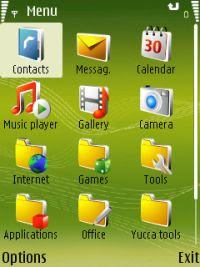
In addition to the manufacturers the community includes:
- Software integration companies such as Sasken, Elektrobit, Teleca, Digia and Mobica
- Semiconductor companies Texas Instruments, ST Microelectronics, Broadcom, SONY , Freescale, Samsung Electronics
- Operators such as Vodafone and Orange who develop and provide S60-based mobile applications and services
- Software developers and independent software vendors (ISVs).
S60 consists of a suite of libraries and standard applications, such as telephony, PIM tools, and Helix-based multimedia players. It is intended to power fully-featured modern phones with large colour screens, which are commonly known as smartphones.
The S60 software is a multivendor standard for smartphones that supports application development in Java MIDP, C++, Python[1] and Adobe Flash. An important feature of S60 phones is that they allow new applications to be installed after purchase.[clarification needed] Unlike a standard desktop platform, however, the built-in apps are rarely upgraded by the vendor beyond bug fixes. New features are only added to phones while they are being developed rather than after public release.
These are a few common features in S60:
- It supports Java ME (MIDP 2.0 commonly, but varies from phone to phone) applications and Symbian C++ applications.
- Certain buttons are standardized, such as a menu key, a four way joystick or d-pad, left and right soft keys and a clear key.
S60 editions :
S60 5th edition idle screen. Bottom left "button" brings up a virtual number pad, to compensate for removal of actual numerical keys.There have been four major releases of S60: "Series 60" (2001), "Series 60 Second Edition" (2003), "Series 60 3rd Edition" (2005) and "S60 5th Edition" (2008).
In S60 1st Edition, the devices' display resolution was fixed to 176x208. Since 2nd Edition Feature Pack 3, S60 supports multiple resolutions, i.e. Basic (176x208), and Double (352x416). Nokia N90 was the first S60 device to support a higher resolution (352x416). Some devices, however, have non-standard resolutions, like the Siemens SX1, with 176x220. Nokia 5500 Sport has a 208x208 screen resolution, and the Nokia E90 with its wide 800x352 inner display.
S60 3rd Edition
(S60v3) uses a hardened version of Symbian OS (v9.1), which has mandatory code signing. In S60v3, a user may install only programs that have a certificate from a registered developer, unless the user disables that feature or modify the phone's firmware through third-party hacks that circumvent the mandatory signing restrictions. This makes software written for S60 1st Edition or 2nd Edition not binary-compatible with S60v3.
In 2006, a "Designed for S60 Devices" logo program for developers was launched. The logotype can be used with conforming programs (Symbian or Java).
S60 5th Edition
In October 2008, S60 5th Edition was launched. (Nokia decided to move from 3rd Edition directly to 5th Edition "as a polite gesture to Asian customers"[3], because the number four means bad luck in some Asian cultures). S60 5th Edition runs on Symbian OS version 9.4[4]. The major feature of 5th Edition is support for high-resolution 640x360 touchscreens; before 5th Edition, all S60 devices had a button-based user interface. S60 5th Edition also integrates standard C/C++ APIs and includes Adobe Flash Lite 3.0 with S60-specific ActionScript extensions that give Flash Lite developers access to phone features like contacts, text messaging, sensors and device location information (GPS).
The S60 5th Edition is the last edition of S60. Its assets along with Symbian OS, UIQ and MOAP(S) have been used as a base for Symbian, an open source operating system being developed by the Symbian Foundation. The first edition of Symbian, Symbian^1, uses S60 5th Edition on top of Symbian OS 9.4 as its base.
S60 versions and supported devices:
Phones are listed in this link: http://mobsolu.blogspot.com/2010/04/nokia-software-platformss40s60.html
Symbian is now progressing through a period of organisational change to metamorph into an open source software platform project. As an OS, Symbian OS originally does not provide a user interface (UI), the visual layer that sits on top of the operating system. This was implemented separately. Examples of Symbian UIs are MOAP; Series 60; Series 80; Series 90 and UIQ. This separation of UI from underlying OS has created both flexibility and some confusion in the market place. The Nokia purchase of Symbian was brokered with the involvement of the other UI developers and all major user interface layers have been (or have been pledged to be) donated to the open source foundation who will independently own the Symbian operating system. The new Symbian Foundation has announced its intention to unify different Symbian UIs into a single UI based on the S60 platform. (Announcements made in March 2009 indicated this would be the S60 5th edition with feature pack 1).
No comments:
Post a Comment